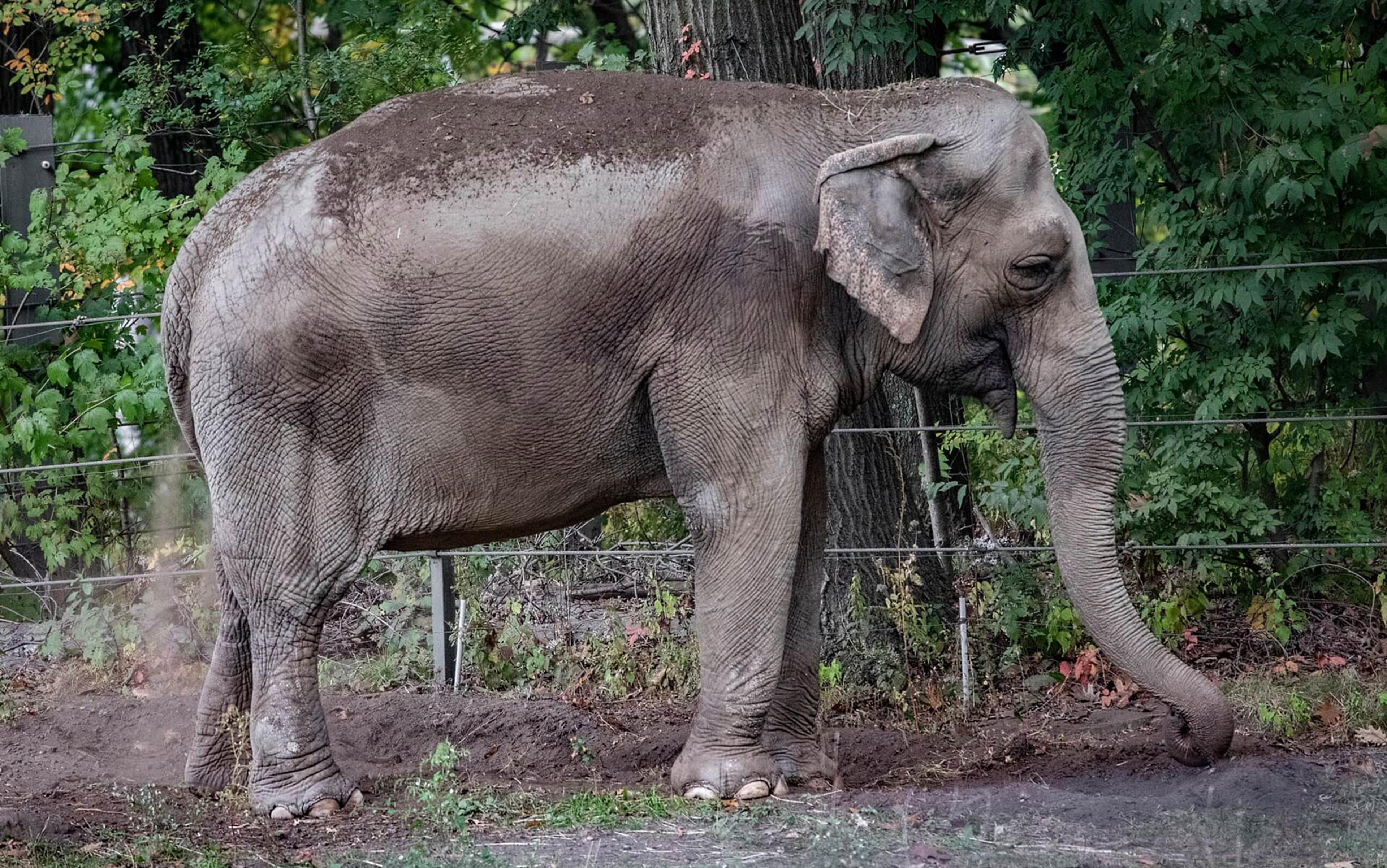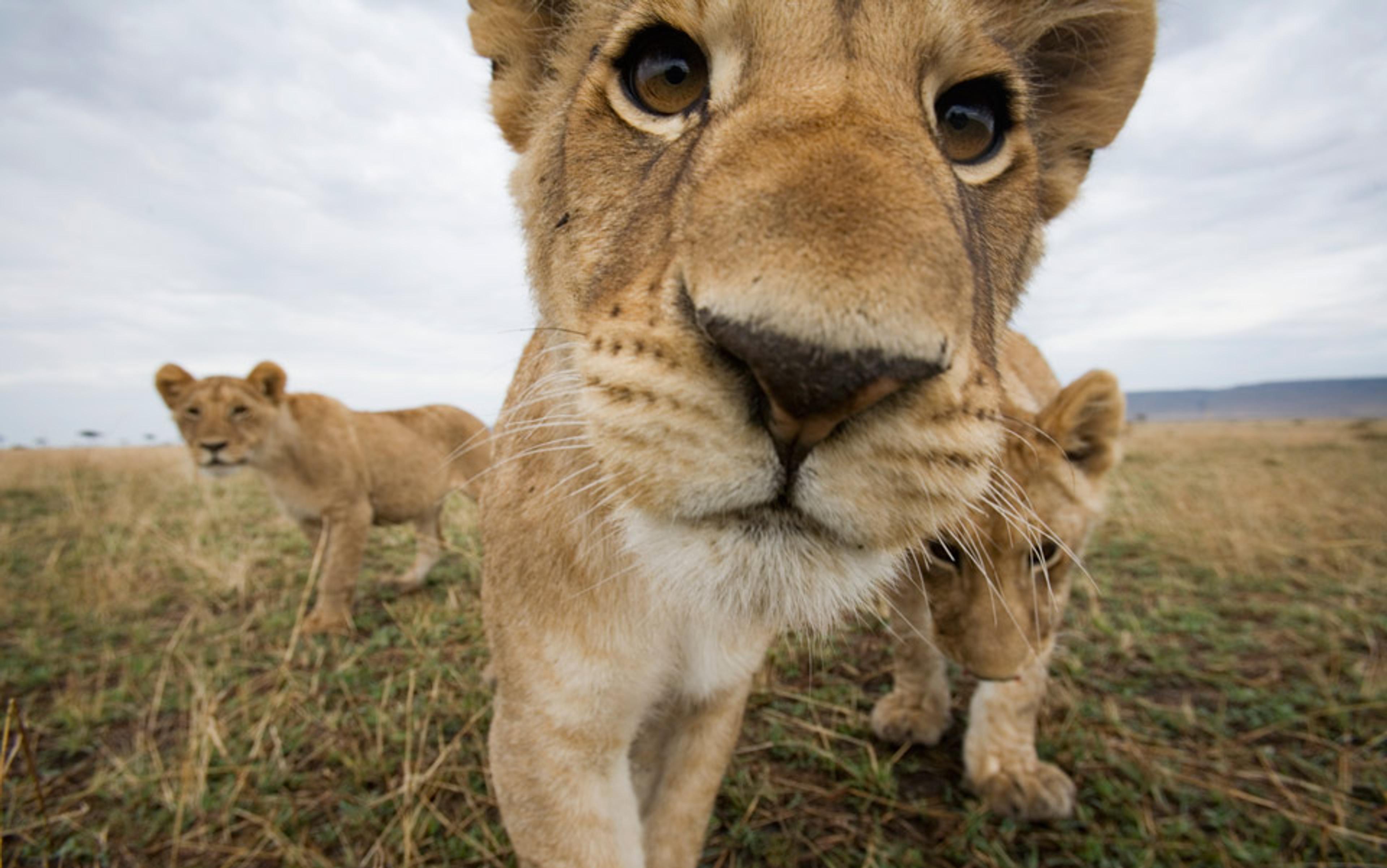Have you ever stood in a field full of cows? It’s obvious that they’re aware of one another, but in a minimal kind of way. They tend to stay loosely clumped together as they graze, and they don’t deliberately knock into other members of the herd. Shouting gets their attention, but it tends to elicit a flickering inspection at most, which subsides into cud-munching indifference when they realise you represent neither a threat nor a treat. Cows don’t gauge how to respond to sights, sounds and smells by carefully studying the subtleties of one another’s reactions (which is why they can startle each other into stampeding). When you’re with a herd of cows, you’re basically alone.
Stand or walk among a herd of elephants, however, and you’ll appreciate how different the experience is. Even the most peaceful group feels electric with communicative action. There’s continuous eye contact, touching, trunk and ear movements to which others attend and respond. Elephants engage in low-frequency vocalisation, most of which you can’t hear, but you can certainly see its effects. If you’re fidgety, for example, all the adult elephants will notice and become uneasy. Typically they take their cues from their female leader, the matriarch. When you’re with a herd of elephants, you’re not alone at all; you’re in a highly charged atmosphere, shimmering with presence and feeling. To an outside observer, elephants appear to have highly responsive minds, with their own autonomous perspectives that yield only to careful, respectful interaction.
What’s the significance of this contrast? We know that elephants are more social – and far more intelligent – than cows. But the comparison goes far beyond the question of intelligence and alertness. I believe it’s possible that elephants have all the cognitive and emotional capacities it takes to be persons. I’m not claiming they belong to the species Homo sapiens, obviously: rather, I mean they might have the potential to deserve the label ‘person’ in recognition of their particular status or identity. Along with many philosophers, I think that being a person involves something different to being a living organism with human DNA.
Don’t get me wrong, I don’t think that elephants currently express the full range of personal and creative capacities that humans do. But I suspect all that’s missing are certain informational and institutional structures, along with the motivations to innovate upon them. In humans, we know what those structures look like: they are the books, movies, museums and laws that manifest in the world what otherwise exists only in our heads. It might be that there’s a lot going on in the heads of elephants, but they just haven’t been moved to externalise and store it in the environment the way we have.
However, if elephants do have all the raw mental material it takes to be persons, a time could come in the near future when we might draw them into a more expansive kind of personhood. The behavioural economics experiments that a colleague and I are planning to run with a group of semi-wild, female elephants in South Africa should begin to test the plausibility of this arresting speculation.
The idea of according elephants the status of persons might seem ridiculous, or naively romantic, or both. But there are sound reasons for taking it seriously, and I think these reasons are both scientifically and morally important. As the philosopher Peter Singer has argued, human moral progress has historically consisted of the steady expansion of the circle of beings we regard as persons. At present, many people treat elephants as objects of entertainment and sources of valuable ivory. Although the international ivory trade was banned in 1989, poaching is on the rise – and in 2017, the US president Donald Trump lifted the US ban on imports. To harvest their tusks, humans slaughter elephants at rates that, if they were persons, would amount to genocide.
Let’s begin the argument with a dramatic story from the history of elephant conservation. At several South African game reserves in the 1990s, rangers kept stumbling upon rhinoceros carcasses with gaping puncture wounds in the neck and shoulders. These rhinos were clearly not victims of poachers, because their horns were intact. It took the authorities some time to identify the perpetrators: young male elephants, who were killing and sometimes sexually assaulting the rhinos. In just one park, Pilanesberg, more than 40 rhinos died this way between 1992 and 1997.
Their killers, like most humans who inflict violence, had troubled childhoods. South African authorities had been doing regular elephant ‘culls’ for much of the 20th century, ostensibly to manage the elephants’ impact on local ecosystems. They preferred not to leave any adult elephant witnesses, because the survivors often became hostile and dangerous. The elephants also appeared to bear witness, in that they spread anxiety to others. So it became common practice to shoot all the adults in a herd. Older male bulls were often targeted, as they had already enjoyed multiple opportunities to spread their genes. Baby elephants, meanwhile, were usually spared. Thus, the culls created orphans.
The rogue young bulls hadn’t had the chance to learn elephant social norms
In her book Elephants on the Edge (2009), the psychiatrist G A Bradshaw argued that many young elephants who’d watched their mothers and relatives being killed went on to exhibit symptoms similar to post-traumatic stress disorder. In females, this expressed itself in social withdrawal, neurotic habits, self-wounding, and dysfunctional parenting. Male orphans, Bradshaw pointed out, laboured under an additional burden. In normal conditions male elephants, upon reaching sexual maturity (c18 years), leave the herd of cows and calves to form bachelor groups, led by older, experienced bulls. But due to the culling, many male babies in Pilanesberg had been raised in reserves without the benefit of this mentorship. Unsurprisingly, all the 18- to 22-year-old male rhino-killers during the 1990s had been orphaned in culls.
A compelling hypothesis is that the rogue behaviour of the young bulls arose because they didn’t have the chance to learn elephant social norms. More evidence for this theory comes from the way the serial killing was brought to a halt. Some of the culprits were shot. But the most effective measure taken by authorities was the introduction of older bull elephants, from other parks. Almost immediately after their arrival, the rhinos stopped being harassed and violated. Human poachers were once again their main threat.
How did the older bulls exert this control? We might be tempted to imagine them imparting fatherly wisdom: ‘Real bull elephants don’t kill or rape rhinos.’ But there are at least two features of the ‘wise lawmaker’ story that could be regarded as implausibly anthropomorphic. First, it appears to rely on the idea that elephants can give verbal instructions – that they can literally talk to one another. Second, it involves the older elephants inducing the younger ones to restrain their impulses by attending to general social norms.
These possible explanations reveal two influential and related ideas about what it takes to be a person: you must have language; and you must be able to regulate your spontaneous emotional responses under the influence of explicit social norms. That gives us two hypotheses to consider in relation to elephants. In the history of ethology (the science of animal behaviour), these criteria are often run together. But it’s important to pry them apart, because it’s key to understanding why I think elephants might have the properties it takes to be basic sorts of persons.
Why should we think of persons as creatures distinguished by language and responsiveness to reasons? The key idea is that our personhood comes from our use of collective ideas about what deserves praise and blame in guiding our actions. That is, we conform to shared assignments of responsibility – reasons – for the consequences of what we do. But this makes no sense unless we suppose that reasons can take precedence over spontaneous, unreflective responses, and can, at least sometimes, be effective causes of our behaviour.
Cases where a human’s personhood is compromised illuminate the meaning of reasons in our lives. Suppose that your supervisor harshly criticises your work, making you feel angry and humiliated. When you interact with her, you will probably suppress or restrain your emotions, because you and your manager are both aware of the professional expectations that normally prevail. But if you were drunk or tired, your observation of these norms might be unreliable. You’d have trouble, we might say, in interacting as a properly responsible person. Similarly, an infant or an adult with severe dementia might not be regarded as a ‘full’ person, because they can’t reliably attend to personal social responsibilities. (In practice, societies often insist on granting these people the legal protections and rights of persons, but under the guardianship of others who are capable of exercising personhood.)
This is where language comes in. To communicate collective reasons, it seems that one must be able to exchange symbols with two general characteristics. First, to talk about events and objects that aren’t currently present – a capacity that linguists refer to as displaced reference. Second, to convey actions and categorical concepts as having logical relationships with one another. (I might say: ‘People can’t eat and talk at the same time,’ even when I am not watching someone attempting it.) This requires structures of meaning (semantics) that are based on rules for ordering signals (syntax). When I refer to ‘language’ here, I mean a signalling system that involves displaced reference and syntax-based semantics.
Elephants who lack direct experiences of their own nonetheless know which groups of humans to avoid
So, turning first to the hypothesis about language: can elephants talk to one another? To try and assess this, we ought to reflect on behaviour that’s hard to explain without displaced reference and abstract communication. For example, in parts of eastern Africa, elephants are hunted by some communities (such as the Maasai), but not by others. Herds have learned both to distinguish between human languages, and to communicate these distinctions to other elephants. In other words, elephants who lack direct experiences with humans hunting them nonetheless know which groups to avoid.
This is only one of many instances of the apparent spread of information, or at least forms of behaviour, from observer elephants to their non-observing conspecifics. To take another example, it’s only recently that Botswana has been safer for elephants than Zambia. But elephants living on the borderlands of those countries now travel rapidly by night when they’re in Zambia, hiding among the trees during the day to avoid detection. Because the adults walk faster than their youngsters, they leave them in the care of stay-behind minders on the Botswana side of the border.
Do behavioural patterns of this kind suggest that elephants can speak? Applied to various species, this question has inspired a huge and passionately contested scientific debate. The possibility of nonhuman language has been investigated most extensively in our nearest living genetic relatives: chimpanzees, bonobos and gorillas. Apes cannot talk for the basic reason that they lack suitably manipulable vocal tracts. However, several well-known apes, including Kanzi the bonobo and Koko the gorilla, were taught to use keyboards or sign-language expressions.
While Kanzi and Koko used their words to demonstrate plenty of intelligence and social alertness, no chimp, bonobo or gorilla has managed to exceed the language skills of a very young human. Such syntax as they have managed to use has been crude and simple, and limited to specific ranges of narrow conditions. Most importantly, it’s not obvious that any ape has ever used language to do anything other than express a relatively immediate desire. Neither Kanzi nor Koko showed inclination to just report on how they viewed the world for the sheer sake of it, something human children do spontaneously and prolifically. Nor is there a clear instance, despite dedicated efforts, of an ape choosing to do something because he or she recognised the social existence of a normative reason for it. Thus, these studies offer little hope for the possibility that we might use language to draw nonhuman apes into human-style conversations about what kinds of actions are good or bad, and why.
Some theorists argue as follows: if our nearest living relatives aren’t naturally prepared for language, then this is a good basis for conjecturing that no nonhumans are. In turn, this suggests that only humans can be persons.
However, this logic ignores convergent evolution: the fact that natural selection often stumbles across the same capacity independently on different branches of the tree of life. The closest living relatives of birds are lizards; lizards cannot fly; but that doesn’t license an inference that no nonbirds can fly. Likewise, the fact that our closest living relatives don’t use language does not justify the conclusion that no other creatures can.
The most important dimension on which hominins split off from other apes was in adopting hypersociality: that is, in developing brains that are specially adapted to coordinating thoughts and actions with others. The current scientific consensus is that this hypersociality coevolved with language. So we shouldn’t be surprised that apes, who are social but not hypersocial, don’t have brains that are prepared for language. They might be smart enough to perform the kinds of mental computations it takes to use language, but they won’t necessarily be motivated to do so. They have not evolved in ways that incline them to share and contrast general views of the world. However, evolution has created hypersociality convergently, in branches of the tree of life that are further from our own than those occupied by chimps and gorillas.
With this in mind, it seems that the search space for nonhuman language use should rely on two general criteria. First, we need behavioural evidence for flexible, intelligent hypersociality that could make language development a viable investment for natural selection. Second, we need evidence of information exchange, using signals that have enough acoustic variation to make it physically possible that they could encode syntax. Dogs meet the first criterion but not the second; many songbirds meet the second criterion but not the first. There is a loose consensus among comparative psychologists that the zone of possibility for both criteria currently boils down to the following animals: parrots, corvids (crows, ravens, jays), toothed whales (dolphins, porpoises, sperm whales, orcas) – and elephants.
It’s important to raise a caveat at this point. Scientific rigour demands that we consider whether there are more frugal explanations for complex behaviour – explanations that don’t involve positing new capacities such as language. For example, in the case of the reformed rhino-killers, part of the story certainly involved the young bulls’ hormonal responses to the presence of the older males. Also, communication by simple emotional contagion, without any use of language-like signalling, is common across a huge range of species. I don’t have the space to work through these alternatives, but the reader can consult my academic work to see why I don’t think these accounts are sufficient to explain the startling range of elephant social coordination and learning. It’s becoming steadily less controversial among scientists that some nonhuman animals, including elephants, can at least send one another signals about states of affairs that aren’t under direct mutual observation – that is, they can achieve displaced reference.
Most scientists, while acknowledging that elephants communicate, still doubt that the semantics of their messages are based on syntax. The majority of researchers have similar doubts about parrots, toothed whales and the other species that possess both hypersociality and enough variance in acoustic signalling to support syntax in principle. However, we can’t have justified opinions on the subject of possible nonhuman languages until we have made a serious, realistic effort to decode their possible grammatical rules, and their other deep structures. This is a demanding challenge and, until very recently, we simply haven’t had the tools to try.
We should not expect the rules of elephant grammar to map on to the syntactic categories of any human language
Elephants use multiple channels for signalling to and with one another. One channel, generating vibrations in the ground, is used for long-distance transmission. Soft, low-frequency vibrations in the air, emanating from both the trunk and the gut, seem to be the main medium at close quarters. (The familiar trumpeting might not involve enough acoustic variation to be useful for anything other than broadcasting urgent emotions such as fear and anger – but it’s clearly used to communicate warnings.) In addition, elephants have a range of standard trunk and head gestures that carry mutually understood signals. Finally, they clearly communicate information by touching one another in specific ways and places. They have receptors for processing information from this tactile probing – which, given their precision control and highly labile trunk lips, supports fine discriminations.
The existence of multiple means of communication is important, because syntax could be encoded in modulation across channels. That is, varying states in one channel (trunk vibrations) could introduce general but systematically related changes to the meanings of signals in another channel (say, trunk touches). In the human symbol system, for example, two identically shaped arrows can mean ‘Turn!’ and ‘Don’t turn!’ if they’re modulated by a second code system in which green means ‘Go!’ and red means ‘Stop!’
A database of elephant recordings is now starting to accumulate in the research community. It attempts to capture acoustic, visual and tactile signals, matched to behavioural observations. But the problem of interpreting these data is vastly more formidable than decoding encrypted human text or vocal messages. If elephant communication has syntax, and if this syntax relies on cross-channel modulation, we shouldn’t expect the rules of elephant grammar to map on to the syntactic categories of any human language. Elephants inhabit deeply different lifeworlds from humans, have different hierarchies of motivation, and make different perceptual discriminations. And, except in the crudest terms, we don’t know much about what elephants might want to say to one another.
New machine-learning techniques, which can identify otherwise hidden patterns in data, could yield breakthroughs. But before we get this decoding mission off the ground, we have no empirical basis to reject the hypothesis that elephants use language. At this stage, a flat-out rejection of the possibility of elephant language is no less rash than naïve acceptance.
What about the second criterion of personhood: that it is fundamentally a function of an organism’s capacity to use and respond to social reasons that others can recognise? Might elephants regulate their emotional and behavioural reactions by reference to norms that they themselves see as such?
Consider again the Pilanesberg rhino-killers, who were ultimately reformed by the older males. Perhaps they were simply emotionally inhibited from demonstrating violence by the perception of angry feelings, or just signs of dangerous hormonal arousal, in the dominant bulls. Something closer to effective norm-recognition must have been involved, however, if the youngsters inferred that they were expected to take steps to calm themselves down. I refer to ‘taking steps’ because we have evidence of how elephants can reduce their own emotional excitement by touching their own faces with their trunks. The fact that the young hooligans didn’t gradually reduce their molestation of rhinos but abruptly stopped it after the arrival of the older bulls is highly suggestive that they recognised a generalised norm. If that capacity could be established, and if it were integrated with linguistic communication, then I think we’d be right to say that elephants were endowed with at least a basic form of personhood.
But humans take normative responses a step further. We not only conform to norms, we innovate upon them. Here our observations suggest an important limitation on the extent of elephants’ possible personhood. Among the most striking characteristics of humans is the way we’ve filled a constantly expanding range of niches – beginning with geographical niches, but extending to more abstract economic ones, in the sense of ‘ways of making a living’. We do this collectively, not individually; and innovation of norms is clearly essential both to coordinating collective exploration and to stabilising the new institutions that maintaining novel niches requires. By contrast, although elephants inhabited a range of climates before our ancestors drove them back into their African and South Asian redoubts, they all sustain themselves in roughly the same way, and in the same way that all their ancestors have done.
Humans are prone to flattering ourselves by interpreting our extraordinary adaptability as simply a reflection of innately unique intelligence. But elephants’ economic limitations are compatible with an alternative hypothesis: that they are simply much more naturally conservative than we are, and don’t attempt significant innovations because they have no inclination to do so. If this is true, perhaps elephants’ limited social-behavioural variation is based mainly on limited motivation, rather than on limited intelligence or a restricted ability to normatively regulate themselves.
Elephants can learn to participate in lotteries: the prizes are turnips, pumpkins and other delicious squashes
The motivations and risk-appetite of elephants can be investigated empirically. They are the basis of experiments that I and another economist colleague, Glenn Harrison of Georgia State University, are preparing to run with a small group of elephants in South Africa.
For several years Harrison and I, along with other colleagues and students, have been estimating the structure and magnitude of risk aversion in various human populations. We do this by giving human subjects sequences of pairs of lotteries and asking them to choose one from each pair. For example, one choice in a sequence of approximately 40 pairs might be between a 50 per cent chance of winning £20, and a 10 per cent chance of winning £100. These choices aren’t just hypothetical: subjects know that they’ll play some of the lotteries they chose for real money. We design the sequences of choices in such a way that we can estimate how our subjects respond to different kinds of risks. Furthermore, we can mathematically combine these estimates with other properties we measure, using additional experimental procedures, to create causal models that explain how varying circumstances affect people’s approaches to taking chances.
Elephants can also learn to participate in lotteries. In our experimental design, the prizes are turnips, pumpkins and other delicious squashes. These experiments won’t require the elephants to be isolated in strange environments. Food lotteries will simply be put into their foraging space, along with visual cues that convey information about the lotteries. We’ll use variation in the shapes of flags to tell them about probabilities, and different flag shades to tell them about magnitudes of possible prizes.
In this way, the elephants can learn how to predict both the magnitudes of (possibly) concealed prizes, and the probabilities that a prize of the relevant magnitude will be found if the elephant chooses to investigate. In each case, choosing one option will close off another that could have been checked out instead. The conditions involve no stress or direct conditioning by humans, or indeed any structured interaction between elephants and people beyond relaxed acquaintance.
Risk aversion is only one aspect of conservatism, but it’s a fundamental one. We soon hope to know something relatively general and mathematically precise about elephants’ willingness to take chances.
Suppose it turns out that the reason elephants everywhere behave in similar ways boils down to conservatism, rather than a lack of intelligence or norms. I predict that we would then want to say that we’d found a limit on the extent to which elephants are persons so far, but these limits appear to be circumstantial rather than fixed. This prediction is grounded in the discovery that normative innovation among humans relies on ‘basic’ personhood as a starting point, but then dynamically, and massively, expands in interaction with tools and other persons. This needs brief explanation.
It is not obvious that preliterate people normatively regulate their societies by reference to reasons, any more than elephants do. The psychologist Jonathan Haidt at New York University has accumulated a range of experimental and observational evidence that he argues shows that natural human normative life is mainly a matter of using culturally evolved social traditions to regulate emotional responses. Even modern people in industrialised societies, Haidt maintains, tend to seek rational justifications for most of their normative judgments only when they’re challenged by contrary opinions, or when their actions are misinterpreted by others and they must explain them by reference to socially approved motivations. The anthropologists Dan Sperber and Hugo Mercier defend similar conclusions in The Enigma of Reason (2017).
This view of the role of reason in human social life might seem to fly in the face of obvious facts. Our contemporary environments teem with institutions and customs that have clear, often announced, and often debated, rationales. But this objection drives home the key point instead of refuting it. As a gathering wave of philosophers argue – including, most prominently, Andy Clark of the University of Edinburgh and Kim Sterelny of the Australian National University – the most important structures for human norms were literally built by us and reside outside of our individual brains.
Consider a domain in which many people go to unusual lengths to use sound general reasons: financial planning for retirement. Most people don’t truly understand such concepts as risk diversification or dynamic rebalancing, and take few or no steps to try to understand them. They rely instead on a simple heuristic: do what has evidently worked for other people comparable to themselves. They can apply this heuristic only because there are well-established, easily accessible and trusted institutions around, such as stockbrokers, interactive websites and pension-fund managers. So, to whatever extent someone doubts that elephants truly respond to explicit reasons, remember that the same is true of human behaviour too.
There is, however, one major distinction that could make all the difference. People not only recognise the existence of norms and other reasons (as I argue elephants might); people also store normative reasons in their environment as a point of reference. Books, websites, software manuals and constitutions are obvious examples; so too are financial services companies. Clark calls this built-up reference environment cognitive scaffolding. This massively amplifies the cognitive, ecological and symbolic complexity of the basic personhood that elephants might already share with us.
Good elephant matriarchs know a lot and make sensible choices. But they don’t publish memoirs
As I pointed out when describing what it’s like to hang out with elephants, they clearly regulate their behaviour, in both crude and nuanced ways, by reference to one another. They are mutually attentive and emotionally attuned. The most important service a good matriarch performs for her herd is to reduce the amplitude of group emotion by keeping calm and showing sound judgment. Good matriarchs know a lot and make sensible choices. They are a kind of cognitive scaffolding for the others. But they don’t publish memoirs for the benefit of their successors. They don’t carve parables on rocks. It’s unlikely that they deliberately and collectively build theoretical knowledge, because to do that beyond a rudimentary level one must keep a record of conjectures and criticisms.
If this line of thinking is right, it is possible that elephants – and parrots, corvids, dolphins and orcas – currently have only the basic elements of personhood but could have full, human-style personhood in their futures. I am suggesting that what stands between elephants and us is not necessarily limited intelligence, limited ability to report facts to one another, or limited ability to signal preferences. Rather, it might be a lack of ability to store records of reasons in the environment. If our deep-learning algorithms can crack the elephant communication code, and enable us to engage in conversation with them, perhaps we could create this means of storage, such that elephants are motivated to attend to it.
This likely wouldn’t imply anything so obvious as trying to teach elephants to read visually displayed text. Our forms of cognitive scaffolding are closely adapted to our brains and the way we process information from our senses. To cite a very simple example, we have trichromatic vision and elephants don’t. More dramatically, we can’t do displaced reference by touching one another; but elephants might be able to, and might need to do so to give full expression to their most important ideas.
Harrison and I think of ourselves as engaged in the early foothills of building cognitive scaffolding for elephants. I call these ‘foothills’ because the signs are about a very limited range of phenomena – availability of food treats – and the entire code is visual. But I like to imagine the grad students of our grad students adding sounds built from the elephant repertoire to probe the deeper dimensions of elephant economics – say, how they frame choices over reward prospects in the relatively distant future. And perhaps the grad students of their grad students will provide elephants with pads they can touch with their trunks, which would enable us to ask them how they’d respond if they saw an elephant attacking a rhino – or if they saw people attacking an elephant.
This potential, if real, would be important for much more than satisfying our curiosity about what elephants prefer and believe. We are presently ruining the environments on which these nonhuman, hypersocial intelligent communicators rely for their survival. We morally distinguish between killing persons and killing nonpersons: the first, but not the second, is murder. Elephants might have the necessary cognitive and emotional capacities for personhood, and even the potential to share joint experience of personhood with us, if we help them acquire new cognitive scaffolding. As Bradshaw describes in her book with justified anguish, they already suffer emotional trauma and normative collapse when people subject them to violence. We have urgent reasons for stopping this slaughter. A time might come soon when we can and should apologise to the victims, in terms they can appreciate as fellow persons.






